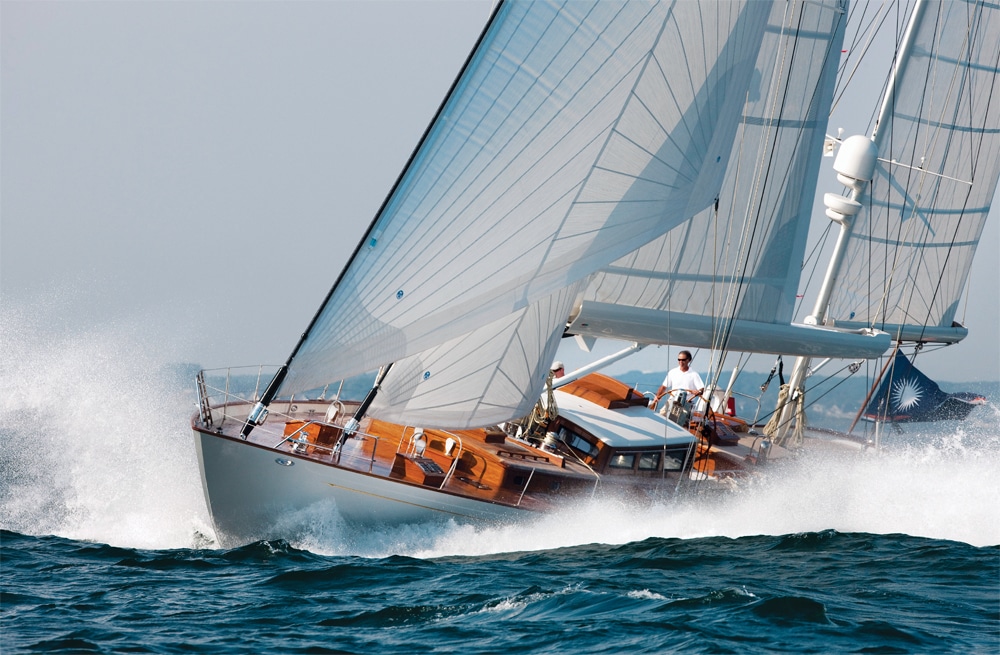
Bequia
Fans of Jackson Pollock would love a printed version of our GPS course from Brooklin to Castine, both in Maine. Like Pollock’s paintings, which appear to be made of randomly applied lines, drips and blotches that were actually quite intentional, our meandering course across an impossibly large area of Penobscot Bay also had a purpose. The techies from North Sails and Southern Spars were aboard Bequia to fine-tune the rig and evaluate the sails. The remainder of the crew came from the yacht’s builder, Brooklin Boat Yard — a fitting reward for their fine workmanship over the two years needed to construct this 90-foot yawl.
That day, July 29, 2009, was the first chance everyone involved with the project — among them designers Bob Stephens and Paul Waring of Stephens, Waring & White Yacht Design — had to work out the kinks before she raced in the Eggemoggin Reach Regatta. This annual event, run early in August, is open only to wooden boats of 26 feet overall and longer, which the organizers place into eight classes. Bequia fits into Class B of the growing Spirit of Tradition category.
Fog, in randomly sized clumps like earthbound clouds, rode the moderate breeze, covering and uncovering our progress while the electronic foghorn’s fronk … fronk sounded with annoying frequency. For the most part, we could see well enough to avoid other boats and islands in the area, and the radar added a measure of reassurance. We motored out of the harbor and into the relatively open waters of Penobscot Bay. Bequia made 9 knots as shown on her GPS, the muted purr of her Cummins auxiliary overpowered by the chatter among the crew on deck. I slipped below for a take on the sound level in the main salon and discovered a pleasant diesel hum — a reassuring presence rather than an intrusion. The undeniably lovely surroundings invited me to stay and explore while we motored. And so I did.
Raised-panel joinery and tongue-and-groove overhead, painted a soft white throughout the accommodations, recall the living spaces of a beachside cottage, and sure enough, that’s what the owners wanted. They refer to the decor as “casual cottage.” The cabin soles, stained ebony, contrast dramatically with all that white but, at the same time, seem to disappear from consciousness and make the interior feel more spacious than it is. A custom overstuffed loveseat and sofa, arranged in the shape of an L on the port side, promise supremely comfortable lounging. Who will be able to resist curling up to read a book in front of the gas fireplace built into the forward bulkhead, or to watch the flatscreen TV hung above the fireplace? The television is cleverly disguised as a mirror until someone pushes the “on” button. An oval coffee table unites the sofa and loveseat — creating an island of pleasure bordered by the boxed-in mast adjacent to the loveseat — bookshelves forward of the sofa and, of course, that wonderful fireplace. The yard’s crew made the table’s top and the shelf beneath from a single piece of mahogany.
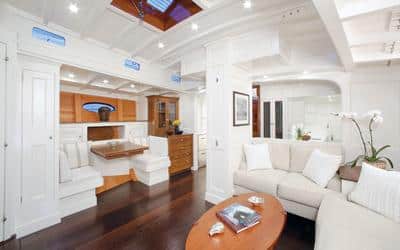
Brooklin Boat Yard built Bequia of Douglas fir (four layers arranged fore-and-aft) and Western red cedar (two layers on the diagonal), cold-molded with epoxy resin and sheathed on the exterior with two layers of 12-ounce fiberglass. She shows off some of her frames belowdecks. Areas of the interior that don’t contain cabinets — behind the sofa is one of those — reveal the inside layer of planking and the framework. This area and the space surrounding the portlights are finished bright, showing the beauty of the wood’s grain. Deck beams divide the overhead into pleasingly proportioned sections. Being able to see even some of the hull’s reinforcing structure has always made me feel safe, as though the boat would take care of me at sea, come what may.
Bequia’s owners selected the colors, style of furniture and purpose assigned to many of the general arrangement’s spaces. They have two teenage daughters and asked, for example, that the forward stateroom be their exclusive domain. Each side has a single berth and hanging locker, shelves at the head of each berth, a head and separate shower. It’s as private, cozy and inviting as any young person could want. Their parents’ stateroom is as far aft as the design permits — every teenager’s dream come true. (Maybe the separation is every parent’s dream too.)
Be that as it may, the master stateroom is also, I have to say, “as private, cozy and inviting” as any reasonable adult could want. The large double berth is on the port side to make room for the companionway that leads to the afterdeck. The steps are removable and stow out of the way, leaving a varnished mahogany bench just to starboard of the centerline. Outboard of the companionway, Stephens placed a large locker in a corner that could easily have become wasted space. A built-in lounge chair, forward of the locker and beneath a portlight, seems like an ideal place to read late at night without disturbing one’s bunk mate.
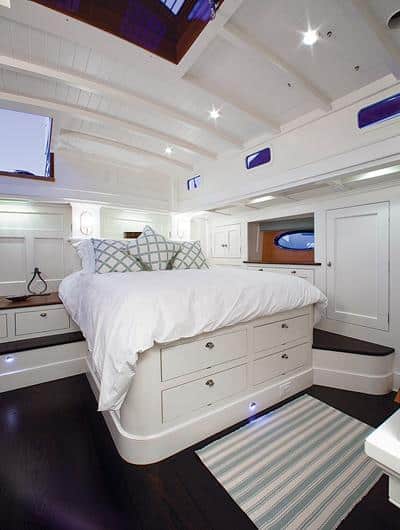
Most of us may reckon that 90 feet overall length provides more than enough volume belowdecks to ease the designer’s burden of including everything the client wanted. Bequia, though, is relatively small for her length. The traditional shape of her hull limits the volume devoted to living spaces, as compared with that of modern yachts, which are broader by far in the stern sections. Her long overhangs aren’t suitable for anything other than stowage, and her deadrise over much of the bottom reduces the percentage of maximum beam devoted to living. For anyone who loves the classical style, these compromises are worth every bit of space given to stowage, instead of extra staterooms, king-size berths, a larger salon or what have you.
From the designer’s point of view, making room for all of the modern systems requires a great deal of thought. Stephens and Waring were certainly up to the task. We find a perfect example of this between the main mast and the master stateroom. This area is chockablock with machinery, galley, captain’s quarters and head, enclosed sea/guest berths and day-head, the master head and about a dozen lockers. The area in question roughly corresponds to the yacht’s static center of buoyancy — the part of the hull most able to float the weight — so it is the best location.
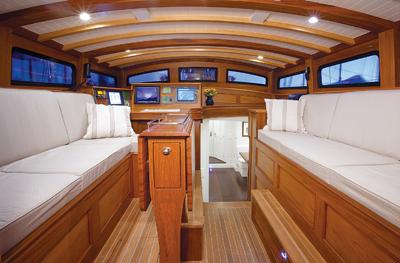
The bulkiest items — engine and generators — live in the forward, or widest, section of the machinery space very near the hull’s point of maximum waterline beam. The after part of the machinery space angles to port, crossing the centerline as it nears the master stateroom’s bulkhead. Here, we find the propeller shaft and the gear-and-shaft linkage of the Jefa steering system. This section forms the inboard wall of the passageway to the master stateroom. The outboard wall of the passageway is also one wall of the master head. Juggling the volume in this way allowed the designers to create a fairly large, though unconventionally shaped, space for the head. The galley lives on the port side of the yacht amidships; the skipper’s quarters are immediately abaft the galley.
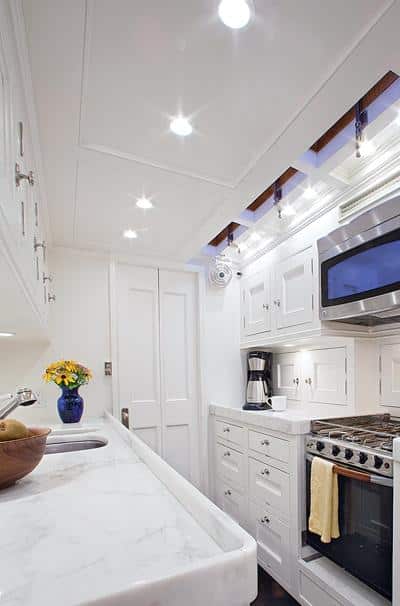
I could have lingered below for the duration, but the topside action beckoned. I emerged from my explorations below to find frenetic activity on deck. Under the command of Bequia’s skipper, Bill Trusdale, the crew systematically hoisted and lowered the entire sail inventory — the yankee, staysail, storm staysail, main, mizzen and mizzen staysail — and each time the guys added or subtracted a sail from the plan, the helmsman had to head up, bear off or hold steady while the experts from North Sails eyeballed the shape. The crew also wanted to evaluate which combination of sails produced the most speed on a given point of sail and wind speed. Below a beam reach, for instance, Bequia gained a knot of speed when the tack of the mizzen staysail was set on the windward pad eye.
Hoisting, lowering, furling, unfurling and trimming the sails — though it seemed hopelessly frantic — require only the push of buttons to summon hydraulic assistance. A row of these buttons on the forward side of the custom steering pedestal furls and unfurls the sails and adjusts the vang, traveler and backstay. Southern Spars made the mainmast and boom from carbon fiber, the mizzenmast from carbon and the mizzen boom from aluminum. Main and mizzen sails roll up on in-boom furlers.
The owners requested a yawl rig, having spent many pleasant hours sailing their Hinckley Bermuda 40. A split rig of this sort allows the crew to balance the yacht by trimming the sails. A case in point: During the passage to Bermuda this past autumn, a section of the steering linkage came loose (the screws hadn’t been secured with Loctite). Bequia steered herself in about 18 knots of wind for the best part of an hour before anyone noticed that the autopilot wasn’t moving the rudder. The owners also reported that Bequia has a very comfortable motion in a seaway, which is what you’d expect of a yacht of her shape below the waterline.
Bequia, apparently, has pleased her owners and ought to bring joy to the heart of anyone who appreciates classical design, intelligently forwarded to the 21st century.
LOA: 90’7″
LWL: 63’5″
Beam: 19’4″
Draft: 9’0″
Displ.: 135,000 lb.
Ballast: 42,500 lb.
Sail Area: 3,424 sq. ft.
Sail Area/Displ.: 20.8
Displ./LWL: 236
Power: 1 x 330-hp Cummins QSB5.9 diesel
Fuel: 800 gal.
Water: 300 gal., plus 2 watermakers
Brooklin Boat Yard, 207-359-2236; www.brooklinboatyard.com
Stephens, Waring & White Yacht Design, 207-359-2594; www.swwyachtdesign.com
**
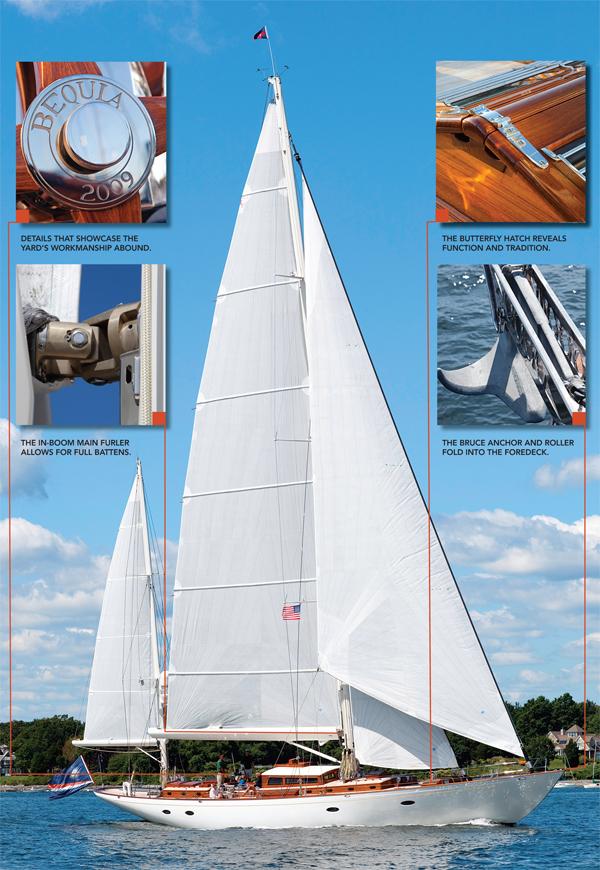
**









